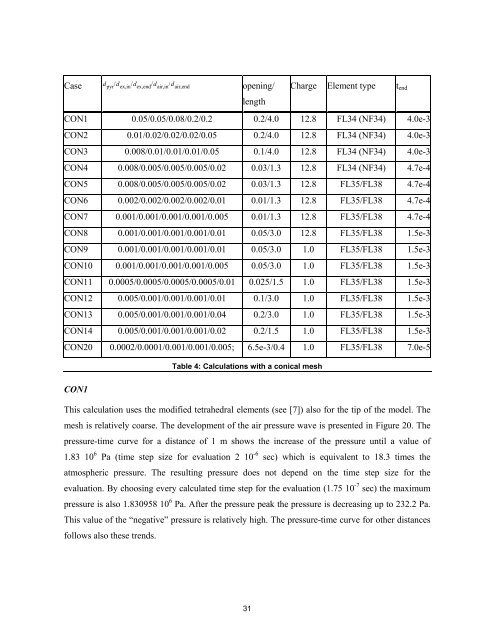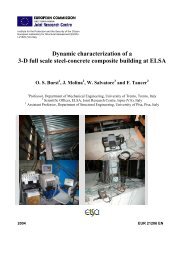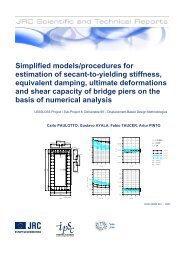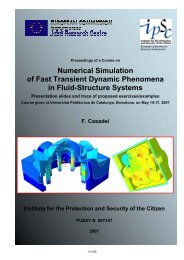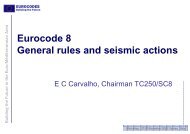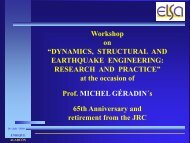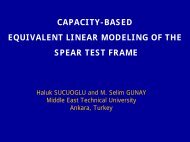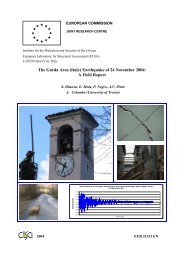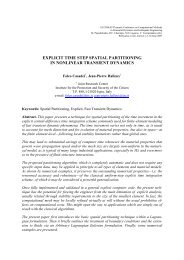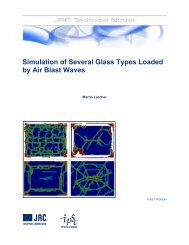Simulation of the Effects of an Air Blast Wave - ELSA - Europa
Simulation of the Effects of an Air Blast Wave - ELSA - Europa
Simulation of the Effects of an Air Blast Wave - ELSA - Europa
- No tags were found...
You also want an ePaper? Increase the reach of your titles
YUMPU automatically turns print PDFs into web optimized ePapers that Google loves.
Cased pyr /d ex,in /d ex,end /d air,in /d air,end opening/ Charge Element type t endlengthCON1 0.05/0.05/0.08/0.2/0.2 0.2/4.0 12.8 FL34 (NF34) 4.0e-3CON2 0.01/0.02/0.02/0.02/0.05 0.2/4.0 12.8 FL34 (NF34) 4.0e-3CON3 0.008/0.01/0.01/0.01/0.05 0.1/4.0 12.8 FL34 (NF34) 4.0e-3CON4 0.008/0.005/0.005/0.005/0.02 0.03/1.3 12.8 FL34 (NF34) 4.7e-4CON5 0.008/0.005/0.005/0.005/0.02 0.03/1.3 12.8 FL35/FL38 4.7e-4CON6 0.002/0.002/0.002/0.002/0.01 0.01/1.3 12.8 FL35/FL38 4.7e-4CON7 0.001/0.001/0.001/0.001/0.005 0.01/1.3 12.8 FL35/FL38 4.7e-4CON8 0.001/0.001/0.001/0.001/0.01 0.05/3.0 12.8 FL35/FL38 1.5e-3CON9 0.001/0.001/0.001/0.001/0.01 0.05/3.0 1.0 FL35/FL38 1.5e-3CON10 0.001/0.001/0.001/0.001/0.005 0.05/3.0 1.0 FL35/FL38 1.5e-3CON11 0.0005/0.0005/0.0005/0.0005/0.01 0.025/1.5 1.0 FL35/FL38 1.5e-3CON12 0.005/0.001/0.001/0.001/0.01 0.1/3.0 1.0 FL35/FL38 1.5e-3CON13 0.005/0.001/0.001/0.001/0.04 0.2/3.0 1.0 FL35/FL38 1.5e-3CON14 0.005/0.001/0.001/0.001/0.02 0.2/1.5 1.0 FL35/FL38 1.5e-3CON20 0.0002/0.0001/0.001/0.001/0.005; 6.5e-3/0.4 1.0 FL35/FL38 7.0e-5Table 4: Calculations with a conical meshCON1This calculation uses <strong>the</strong> modified tetrahedral elements (see [7]) also for <strong>the</strong> tip <strong>of</strong> <strong>the</strong> model. Themesh is relatively coarse. The development <strong>of</strong> <strong>the</strong> air pressure wave is presented in Figure 20. Thepressure-time curve for a dist<strong>an</strong>ce <strong>of</strong> 1 m shows <strong>the</strong> increase <strong>of</strong> <strong>the</strong> pressure until a value <strong>of</strong>1.83 10 6 Pa (time step size for evaluation 2 10 -6 sec) which is equivalent to 18.3 times <strong>the</strong>atmospheric pressure. The resulting pressure does not depend on <strong>the</strong> time step size for <strong>the</strong>evaluation. By choosing every calculated time step for <strong>the</strong> evaluation (1.75 10 -7 sec) <strong>the</strong> maximumpressure is also 1.830958 10 6 Pa. After <strong>the</strong> pressure peak <strong>the</strong> pressure is decreasing up to 232.2 Pa.This value <strong>of</strong> <strong>the</strong> “negative” pressure is relatively high. The pressure-time curve for o<strong>the</strong>r dist<strong>an</strong>cesfollows also <strong>the</strong>se trends.31


